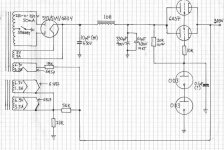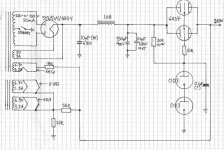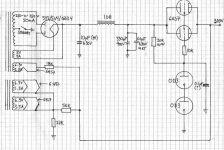I built Eric Barbour's "Brute Force" pre-/headphone amp this spring (it sounds great!) and I'm finally going to finish it with a nice (that's what I'm hoping...) chassis. Before I transplant everything, I'd like your opinion on the power supply.
I'm using 6 x 51V zeners for regulation at the moment, but is it as simple as just replacing them with 0D3 tubes as I've done on the schematic? Nothing else have been changed.
In short: will this work?
I'm using 6 x 51V zeners for regulation at the moment, but is it as simple as just replacing them with 0D3 tubes as I've done on the schematic? Nothing else have been changed.
In short: will this work?
Attachments
As a new user, your posts go through a manual moderation process. Sometimes it takes a little while for the attachments to post. Sorry about that.
It will probably work.
Several dubious things.
250VAC will give 350V raw B+, not counting rectifier loss. If your wall-power varies +/-20% it gives 295VDC to 424VDC. Allowing 50V loss in rectifier and 50V-100V drop in the 6AS7, it is not going to regulate except when utility power is high.
If we pretend we get +350V raw B+, and OD3 is 150V(?), then we have 350V-300V= 40V across the 20K resistor, which is 40V/20K= 2mA, which is lower than the suggested current in OD3 tubes (5mA-35mA, IIRC). 50V 0.5W Zeners work OK to lower current than gas tubes.
If it lights (you need more than 150V to start the gas discharge), at 2mA it will not be quite 150V and will not be stable.
Gas tubes are far noisier than Zeners. The 0.1uFd helps, but that is an absolute maximum (any more and it oscillates). You have a 10K to the 6SA7 grids, toss a 0.1uFd cap from grid to ground to swamp audio noise.
Your load is only a couple 6BL7 and some 6SN7? Not a lot of current. What is the grid-cathode voltage for 6AS7 at such low current? It may be high, which means your output is trying to go much higher than 300V. However your raw supply voltage is not much higher than 300V, at about 350V (300V-400V). You could end up in a range where the grid has less control than the plate. In that case, the 6AS7 is just a very expensive resistor.
What _I_ would think: starting with +300V output, I would pencil 100V across the pass-tube and 50V across the rectifier, +450V raw supply. I'd check my expected power-utility variation: maybe I need 10% more raw B+, maybe the pass-tube will work to much less than 100V drop and I can let it handle brown-outs. Then +450V raw B+ suggests a 315VAC winding (320V-0-320V if you use the twin-rectifier). Given the small size of that 10uFd input cap, I would check where the bottom of the ripple lay, and maybe add another 5%-10%, 330VAC or 345VAC.
OTOH, if it "sounds great!" and has satisfied for months, maybe you are OK on gross voltage. I'd still run the OD3 current up to 5mA-10mA, and add a noise-filter to the 6AS7 grids.
Several dubious things.
250VAC will give 350V raw B+, not counting rectifier loss. If your wall-power varies +/-20% it gives 295VDC to 424VDC. Allowing 50V loss in rectifier and 50V-100V drop in the 6AS7, it is not going to regulate except when utility power is high.
If we pretend we get +350V raw B+, and OD3 is 150V(?), then we have 350V-300V= 40V across the 20K resistor, which is 40V/20K= 2mA, which is lower than the suggested current in OD3 tubes (5mA-35mA, IIRC). 50V 0.5W Zeners work OK to lower current than gas tubes.
If it lights (you need more than 150V to start the gas discharge), at 2mA it will not be quite 150V and will not be stable.
Gas tubes are far noisier than Zeners. The 0.1uFd helps, but that is an absolute maximum (any more and it oscillates). You have a 10K to the 6SA7 grids, toss a 0.1uFd cap from grid to ground to swamp audio noise.
Your load is only a couple 6BL7 and some 6SN7? Not a lot of current. What is the grid-cathode voltage for 6AS7 at such low current? It may be high, which means your output is trying to go much higher than 300V. However your raw supply voltage is not much higher than 300V, at about 350V (300V-400V). You could end up in a range where the grid has less control than the plate. In that case, the 6AS7 is just a very expensive resistor.
What _I_ would think: starting with +300V output, I would pencil 100V across the pass-tube and 50V across the rectifier, +450V raw supply. I'd check my expected power-utility variation: maybe I need 10% more raw B+, maybe the pass-tube will work to much less than 100V drop and I can let it handle brown-outs. Then +450V raw B+ suggests a 315VAC winding (320V-0-320V if you use the twin-rectifier). Given the small size of that 10uFd input cap, I would check where the bottom of the ripple lay, and maybe add another 5%-10%, 330VAC or 345VAC.
OTOH, if it "sounds great!" and has satisfied for months, maybe you are OK on gross voltage. I'd still run the OD3 current up to 5mA-10mA, and add a noise-filter to the 6AS7 grids.
PRR said:Gas tubes are far noisier than Zeners. The 0.1uFd helps, but that is an absolute maximum (any more and it oscillates). You have a 10K to the 6SA7 grids, toss a 0.1uFd cap from grid to ground to swamp audio noise.
That's not what I'm finding.....Unless I've a batch of good OA2s/OB2's....100V+ zeners in comparison are bxxy dreadful.
richj
PRR:
Thank you very much for the reply - this is my first build, so I'm quite new at this, but if I understand correctly:
The problem would be getting enough B+ to light the 0D3s. So if it doesn't light up, some of my options could be:
- bigger input cap to bump up the voltage
- rectifier with lower voltage drop, say a GZ34 instead of the 5Y3 I have now?
- perhaps replacing the 20K resistor with something lower? 10K?
Also, you mention that gas tubes are noisy. Will it be audible hiss or 100Hz hum or something else? Will I be better off with the Zeners noise-wise?
Thank you very much for the reply - this is my first build, so I'm quite new at this, but if I understand correctly:
The problem would be getting enough B+ to light the 0D3s. So if it doesn't light up, some of my options could be:
- bigger input cap to bump up the voltage
- rectifier with lower voltage drop, say a GZ34 instead of the 5Y3 I have now?
- perhaps replacing the 20K resistor with something lower? 10K?
Also, you mention that gas tubes are noisy. Will it be audible hiss or 100Hz hum or something else? Will I be better off with the Zeners noise-wise?
The ground of the 0.1uf bypass of the 0d3 should be tied to the cathode (ground) of the second 0d3 instead of just starground to ground.
I am not sure about this one, but don't you need separate grid resistor for each pass element?
I am not sure about this one, but don't you need separate grid resistor for each pass element?
Take this with a grain of salt because I've haven't used them but I'm sure I ran across an extensive application note by one of the old manufacturers which discouraged parallelling 6AS7s due to poor device matching, even in the same envelope.
Well what do you know, found it in my stash. Full pdf too big to post here. RCA Ham Tips, October-December 1947. The very first of nine rules: "The two units should always be used in push-pull, never parallel."
Well what do you know, found it in my stash. Full pdf too big to post here. RCA Ham Tips, October-December 1947. The very first of nine rules: "The two units should always be used in push-pull, never parallel."
Gas tubes are far noisier than Zeners.
It depends how you compare, high voltage Zeners without any parallell caps for filtering are usually much noiser than gas tubes without filtering. In addition the dynamic resistance of high voltage zeners and the temperature drift is much worse.
It can be argued that noise from Zeners is easy to filter out by using large value parallell caps but there can still be a problem with very low frequency 1/f dependant noise in circuits like RIAA amplifiers. Gas tubes has less 1/f noise but are OTOH more difficult to filter as they can't take large caps without oscillating.
Maybe it is also worth knowing that large value zeners are not strictly zener diodes, i.e they don't rely on the Zener effect for their function, all "zener" diodes over 5.6 V are avalanche type diodes that have less sharp knees than real zener diodes, higher dynamic resistance and higher temperature coefficient.
Regards Hans
Here's a supply I built for my EL36 SET that works well with a single -82V Zener reference. It's based on the design by Steve Bench. Noise, from the zener is neglible.
A little more than you may need, but you can use it as a reference for a regulated supply 🙂
http://geek.scorpiorising.ca/contrib/Geek/EL36-SET_power_final.png
A little more than you may need, but you can use it as a reference for a regulated supply 🙂
http://geek.scorpiorising.ca/contrib/Geek/EL36-SET_power_final.png
- Status
- Not open for further replies.
- Home
- Amplifiers
- Tubes / Valves
- Does this look right to you?


